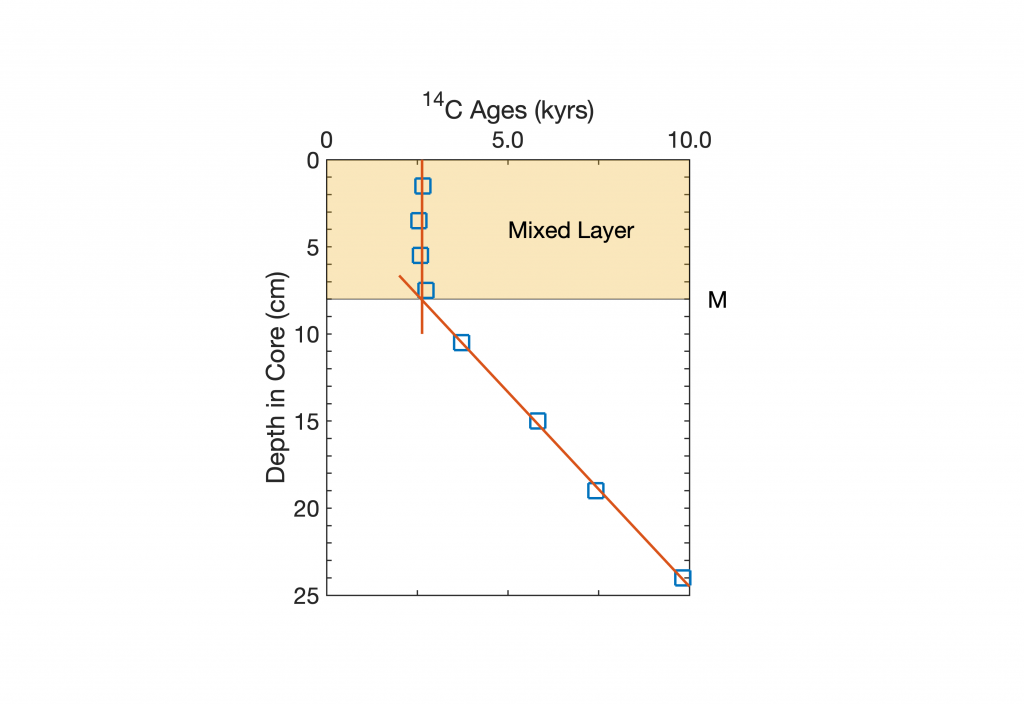Bioturbation (or benthic mixing) causes significant distortions in marine stable isotope signals and other palaeoceanographic records. In an earlier post I introduced a MATLAB-based model to study the effect of bioturbation on isotopic signals from stratigraphic carriers such as foraminifera. This post will demonstrate how to create a publishable figure showing the uppermost layers of a sediment sequence affected by bioturbation. The following posts will introduce MATLAB-based animations of the benthic mixing.
The classic way to describe benthic mixing or bioturbation on the deep-sea floor is to postulate a mixed layer of a specific thickness M (marked by yellow shading, typically between M=0 and M=20 cm, global average about M=8 cm), resting on top of a sediment pile that is not influenced by benthic activity (e.g. Berger and Heath, 1968). Many studies on the distribution of high-resolution 14C data series (marked by blue squares) in box core profiles have shown instantaneous mixing within such a layer and suggest that this model describes the process of bioturbation in the deep-sea sediments sufficiently accurately, at least on radiocarbon time scales. Here is a script to create a graphics similar to Figure 2 of my paper published in Paleoceanography (Trauth et al., 1997) which uses 14C data of Buffoni et al. (1992), showing the uppermost layers of a sediment sequence affected by bioturbation.
clc, clear, close all
data = [ 1.5 2.654
3.5 2.546
5.5 2.585
7.5 2.743
10.5 3.721
15.0 5.821
19.0 7.425
24.0 9.820];
p1 = mean(data(1:4,2));
p2 = polyfit(data(5:end,2),data(5:end,1),1);
XTickLabelCell = {'0';' ';'5.0';' ';'10.0'};
YTickLabelCell = {'0';' ';' ';' ';' ';...
'5';' ';' ';' ';' ';...
'10';' ';' ';' ';' ';...
'15';' ';' ';' ';' ';...
'20';' ';' ';' ';' ';...
'25'};
figure('Position',[50 100 800 550],...
'Color',[1 1 1]);
axes('Units','Centimeters',...
'Position',[9 3 10 12],...
'XLim',[0 10],...
'YLim',[0 25],...
'Box','On',...
'LineWidth',1,...
'FontSize',18,...
'XTickLabel',XTickLabelCell,...
'XTick',[0 2.5 5.0 7.5 10.0],...
'YTickLabel',YTickLabelCell,...
'YTick',0:25,...
'YDir','reverse',...
'XAxisLocation','Top')
hold on
xlabel('^{14}C Ages (kyrs)')
ylabel('Depth in Core (cm)')
patch([0 10 10 0],[0 0 8 8],...
[0.9290 0.6940 0.1250],...
'FaceAlpha',0.3)
line(data(:,2),data(:,1),...
'LineStyle','none',...
'Marker','square',...
'MarkerSize',15,...
'LineWidth',2)
line([p1 p1],[0 10],...
'Color',[0.8500 0.3250 0.0980],...
'LineWidth',2)
line([2 10],polyval(p2,[2 10]),...
'Color',[0.8500 0.3250 0.0980],...
'LineWidth',2)
text(5,4,'Mixed Layer',...
'FontSize',18)
text(10.5,8,'M',...
'FontSize',18)
print -dpng -r300 bioturbationgraphics.png
References
Berger, W.H., Heath, R.G. (1968) Vertical mixing in pelagic sediments. Journal of Marine Research 26, 134–143.
Buffoni, G., Delfanti, R., Papucci, C. (1992): Accumulation rates and mixing processes in near-surface North Atlantik sediments: Evidence from C-14 and Pu-239,240 downcore profiles. – Mar. Geol., 109, 159-170.
Trauth, M.H., Sarnthein, M., Arnold, M. (1997) Bioturbational mixing depth and carbon flux at the seafloor. Paleoceanography, 12, 517-526.
Trauth, M.H. (1998) TURBO: a dynamic-probabilistic simulation to study the effects of bioturbation on paleoceanographic time series. Computers and Geosciences, 24(5), 433-441.
Trauth, M.H. (2013) TURBO2: A MATLAB simulation to study the effects of bioturbation on paleoceanographic time series. Computers and Geosciences, 61, 1-10.

